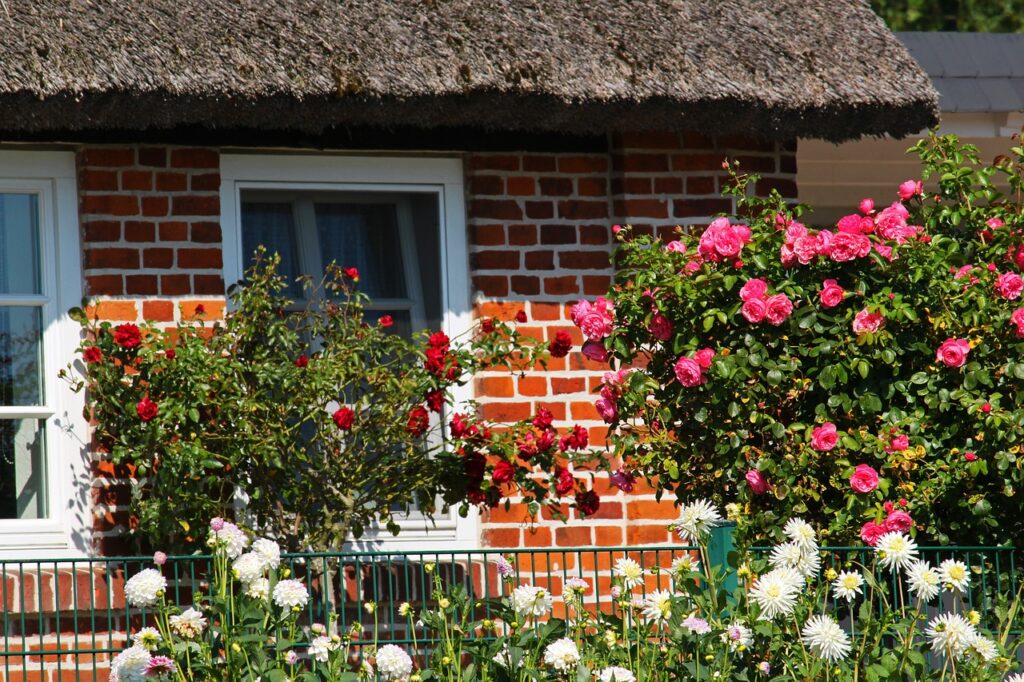Adding flower beds to your front yard can significantly enhance its curb appeal, making it inviting and warm for guests. Not only do they add a burst of color and texture to your outdoor space, but they can also be a low-maintenance and beautiful addition to your garden. In this article, we’ll explore some design ideas for your front yard flower beds to help inspire your creative side.
1. Low-Maintenance Perennials
If you’re looking for a hassle-free way to add some beautiful color to your front yard, low-maintenance perennials are a great option to consider. These plants are easy to care for and will return year after year, making them a budget-friendly choice. The best choices for low-maintenance perennials include daylilies and sedum. Daylilies come in a variety of bright colors and require minimal watering and fertilizer. Sedum is a hardy plant that can grow in almost any soil type and requires little maintenance. Both of these plants will provide colorful blooms to your garden without the need for constant upkeep.
- Choose daylilies or sedum for a low-maintenance option.
- Both plants require minimal watering and fertilizer.
- Sedum can grow in almost any soil type and doesn’t require much care.
- Daylilies come in a variety of colors and provide bright blooms to your garden.
2. Vertical Flower Beds
Creating a vertical flower bed is a perfect solution for those who don’t have a lot of space in their front yard. Hanging pots from a trellis can create a beautiful and unique display. Not only is it practical for small yards and apartment balconies, but it also adds a visually interesting element to the landscape.
Another way to create a vertical flower bed is by using a living wall. Plants like ivy or fuchsia can be planted in a vertical garden planter that is attached to a wall or fence. This not only adds a pop of color to your yard, but it can also provide natural shading and insulation for your home.
When choosing plants for your vertical flower bed, consider the amount of sunlight the area receives and the type of soil it has. Succulent plants like sedum are a great option as they require very little maintenance and can withstand hot and dry conditions. Adding trailing plants like sweet potato vine or petunias can add a cascading effect, adding depth and dimension to your display.
In summary, creating a vertical flower bed is an excellent way to add a unique and practical element to your front yard. Whether through hanging pots or a living wall, it’s a great option for small yards or apartment living. Choosing the right plants and considering the amount of sunlight and soil type can ensure a lush and vibrant display.
2.1. Trellis Flower Beds
Trellis flower beds are a great way to add vertical height to your front yard and create a stunning display with climbing plants like roses or clematis. A trellis is an excellent option for those with limited space or for those who want to create a unique garden feature.
You can choose to place your trellis against a wall or fence or use it as a standalone structure. Plant climbing flowers and vines at the base of the trellis and guide them to grow upwards by tying them to the structure. This will create a beautiful display of colors and textures in your garden.
Remember to choose the right type of trellis for your plants. A sturdy trellis made of metal or wood is ideal for heavy climbers like roses, while a lightweight wire trellis is perfect for lighter vines like clematis.
When it comes to adding a trellis flower bed to your front yard, you can get as creative as you like. Use colorful pots to plant your climbing flowers, or install a trellis archway to welcome guests into your garden. The possibilities are endless, and with a bit of creativity, your front yard can be transformed into a stunning oasis.
3. Color Coordination
When it comes to selecting the right flowers for your front yard, it’s important to choose a color scheme that coordinates with your home’s exterior. If your home is a neutral color, such as beige or white, you can add pops of bright and bold colors to create a statement. Consider using flowers like dahlias, zinnias, or marigolds to add a burst of color to your yard.
On the other hand, if your home is already colorful, you should select flowers that complement the existing color palette. For instance, if your home has a lot of blue accents, adding flowers in shades of purple and pink can help create a cohesive and visually pleasing look. Some great flower options to consider include petunias, pansies, and salvia.
To take your color coordination to the next level, consider creating a color wheel. This tool can help you determine which colors will complement each other and create a cohesive look. You can create your color wheel using a piece of paper and some colored pencils.
In addition to color coordination, consider the size and shape of the flowers. For instance, if you have a tall home, you may want to opt for taller flowers like sunflowers or hollyhocks to balance out the height. Alternatively, if you have a smaller home, using smaller, dainty flowers like pansies or violas can help create a charming and inviting look.
Overall, selecting the right color scheme and flower sizes can help you create a stunning and cohesive front yard. With the options available, you’re sure to find the perfect flowers to enhance your home’s curb appeal.
4. Flower Bed Borders
Adding borders to your flower beds is not just aesthetically pleasing but also serves to provide structure and definition to your garden. The borders also help keep your garden tidy and prevent plants from growing outside their designated space. There are different materials that can be used to create a border around your flower bed, including stone, bricks, and plants like lavender or catmint. Stone borders, in particular, give a natural and organic touch to the garden. They come in different sizes and shapes, allowing for a unique and beautiful border to be created. Bricks can also be used to add a touch of classic elegance to your garden. Plant borders, on the other hand, are perfect for those who prefer a more organic and natural look. Lavender or catmint can be used to both border and fragrance your garden. Choose the type of border that best fits the style and theme of your garden, and watch as it transforms your flower bed into an inviting space.
4.1. Stone Borders
Adding a stone border to your front yard flower bed can create a beautiful and natural look. There are many different options for stones, including river rocks, limestone, granite, and more. You can mix and match sizes and shapes for a unique border that complements your flowers. Additionally, stones can help retain moisture in the soil and regulate temperature, which can be beneficial for your plants.
When creating a stone border, it’s important to also consider the layout of your flower bed. You may want to create a curved border to add visual interest and soften the lines of your yard. Alternatively, a straight border can help create structure and define the space.
Another option is to use stones within the flower bed as well. You can add larger rocks or boulders for a natural focal point, or use pebbles or crushed stone to create a walkway through the flower bed. The possibilities are endless when it comes to incorporating stones into your front yard landscaping.
5. Container Gardens
Container gardens are a fantastic option for those who want a little bit of greenery in their front yard but don’t have the time or space for a larger garden. With container gardens, you can choose from a variety of colorful pots and fill them with your favorite annuals or perennials. The best part is that you can move them around your yard to create a different look whenever you please.
One great idea for a container garden is to choose a variety of different sized pots and arrange them in a cluster to create a visually interesting display. You can also choose pots that are the same size and line them up along your front porch or walkway for a clean and organized look.
When choosing plants for your container garden, consider the location where they will be placed. If they will be in a sunny spot, opt for plants like marigolds or petunias. If they will be in a shady area, choose plants like impatiens or begonias. And don’t forget to water your plants regularly to ensure they thrive!
5.1. Hanging Container Gardens
Hanging container gardens are a great solution for those who want to add some greenery to their small outdoor spaces such as balconies or porches. They offer a versatile and attractive way to grow plants and provide a creative display that can be easily changed and rearranged.
You can easily create a hanging container garden by using a variety of small pots and hanging them from a trellis or other vertical structure. You can choose different colors and textures of pots to add depth and variety to your garden. Hanging gardens also help to maximize space, as they allow you to use vertical space rather than just relying on ground-level areas.
- Choose a variety of plants that thrive in hanging containers, such as adiantum, bacopa, begonias, fuchsias, and petunias.
- Ensure the containers have good drainage and are hung securely to avoid tipping or falling.
- Consider the weight of the containers when selecting a location to hang them.
- Water your hanging container garden regularly to keep the plants healthy and vibrant.
Hanging container gardens not only add beauty to your outdoor space but also provide a sense of relaxation and tranquility. Get creative and design a stunning hanging garden that complements your personality and style.



